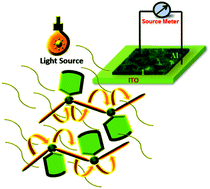Synthesis of a Zn(ii)-based 1D zigzag coordination polymer for the fabrication of optoelectronic devices with remarkably high photosensitivity†
Abstract
A Zn(II) based one-dimensional coordination polymer (1D CP), [Zn4(adc)4(4-cltpy)4]·CH3OH·2H2O (1) (H2adc = acetylenedicarboxylic acid and 4-cltpy = 4′-chloro-[2,2′;6′,2′′] terpyridine), has been synthesized by a slow diffusion method and characterized by X-ray crystallography. Here, the linear adc ligand acts as the linker between two Zn(II) centers and a chelating 4-cltpy ligand is appended at the metal node. The connectivity of the ligands with metal ions generates a 1D zigzag polymeric chain. The zigzag chains are aggregated through various secondary interactions to construct a three-dimensional (3D) structure. The optical band gap has been determined and correlated with the theoretical band gap calculated by density functional theory (DFT) computations, which reveals that compound 1 possesses semiconducting properties. Moreover, compound 1 shows remarkably high photosensitivity (PS = 1134) upon illumination by light. Therefore, compound 1 has the potential to be used in optoelectronic devices and solar cells.



 Please wait while we load your content...
Please wait while we load your content...